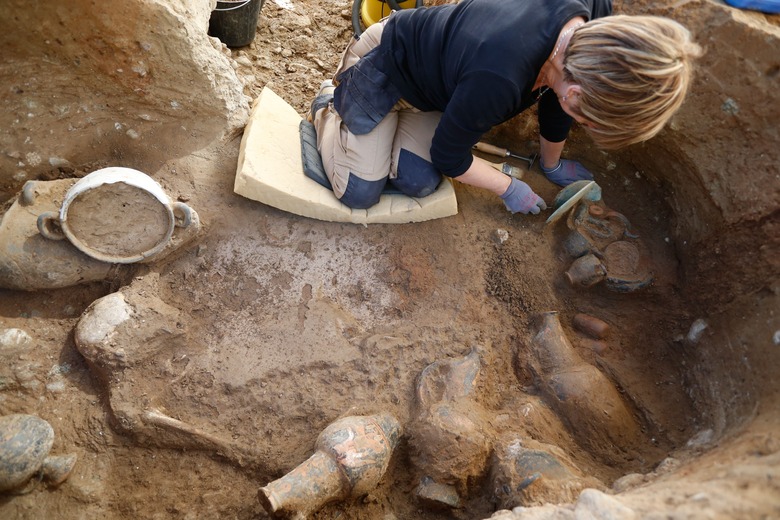Why North Dakota's Prehistoric Graveyard Is Raising Eyebrows
Broken bones and teeth. Remains of hatchlings from almost every group of dinosaurs. Part of a Triceratops carcass. A dinosaur egg, containing an embryo. Fossilized branches, trees, flowers and fish. They're all there.
Robert A. DePalma, a Palm Beach Museum of Natural History paleontologist and University of Kansas graduate student, unearthed these organic remains in a secret dig of a fossil bed in North Dakota. The fossilized graveyard, dubbed Tanis, appears to show immediate results of the asteroid impact that ultimately terminated three-quarters of life on Earth, including all land-dwelling dinosaurs, at the end of the Cretaceous Period (or the K-T boundary).
"This is the first mass death assemblage of large organisms anyone has found associated with the K-T boundary," DePalma told Science Daily. "At no other K-T boundary section on Earth can you find such a collection consisting of a large number of species representing different ages of organisms and different stages of life, all of which died at the same time, on the same day."
What it Tells Us
What it Tells Us
When the meteor struck Earth near the current Yucatan Peninsula nearly 66 million years ago, it created a massive crater, now known as Chicxulub. It also sparked titanics and earthquakes radiating thousands of miles, sweeping sea creatures inland and mixing them in with land-dwelling organisms, entombing and preserving them in molten rock.
That's how this unique, prehistoric North Dakota graveyard – the most accurate snapshot yet discovered of that day's events – came to be. Scientists believe the impact that created Tanis occurred within an hour, and perhaps even within minutes, of the asteroid's initial blow.
The Chicxulub impact and its ramifications are widely known as the causes of dinosaurs' downfall. However, according to the New York Times, many scientists have argued that volcanic eruptions, climatic disruptions and other, longer-term factors might have contributed dinosaurs' extinction, as well. DePalma's findings in the North Dakota graveyard dispute those arguments, seeming to directly associate the asteroid's impact with the end of dinosaurs.
The New Yorker published a profile of DePalma's dig, and quoted paleontologist Jan Smit on the meaning behind the North Dakota findings.
"It solves the question of whether dinosaurs went extinct at exactly that level or whether they declined before," Smit told the New Yorker. "And this is the first time we have seen direct victims."
Publishing About Tanis
Publishing About Tanis
DePalma's work has been unfolding for years; he initially received permission to begin digging in that North Dakota fossil bed in 2012. He kept the dig top-secret as it progressed, since – as New Yorker contributor Douglas Preston wrote – "the history of paleontology is full of tales of bribery, backstabbing,, and double-dealing."
Now it's public. An international team of 12 scientists described the dig in a paper in science journal Proceedings of the National Academy of Sciences, released to select sources on March 29, 2018. Steve Brusatte, a vertebrate paleontologist and evolutionary biologist at the University of Edinburgh, expressed some confusion regarding how the paper described fossil findings in Tanis.
"But the research paper is not about dinosaurs," Brusatte wrote in an April 1 tweet. "The [New Yorker] article breathlessly describes a 'graveyard' with bones of all the major Hell Creek dinosaurs, plus feathers, and eggs, and even embryos. None of this is in the research paper: just one mention of one dinosaur bone."
DePalma told the New York Times that more information on dinosaurs and other organisms that died and were preserved in Tanis is to come in subsequent papers. The initial paper was meant to establish the geology and timing of the events of the Chicxulub impact.
"It wasn't a paper about dinosaurs," DePalma told the New York Times. "This was a basic overview of the site and how it was formed."
Cite This Article
MLA
Swanston, Brenna. "Why North Dakota's Prehistoric Graveyard Is Raising Eyebrows" sciencing.com, https://www.sciencing.com/why-north-dakotas-prehistoric-graveyard-is-raising-eyebrows-13718280/. 8 April 2019.
APA
Swanston, Brenna. (2019, April 8). Why North Dakota's Prehistoric Graveyard Is Raising Eyebrows. sciencing.com. Retrieved from https://www.sciencing.com/why-north-dakotas-prehistoric-graveyard-is-raising-eyebrows-13718280/
Chicago
Swanston, Brenna. Why North Dakota's Prehistoric Graveyard Is Raising Eyebrows last modified March 24, 2022. https://www.sciencing.com/why-north-dakotas-prehistoric-graveyard-is-raising-eyebrows-13718280/
